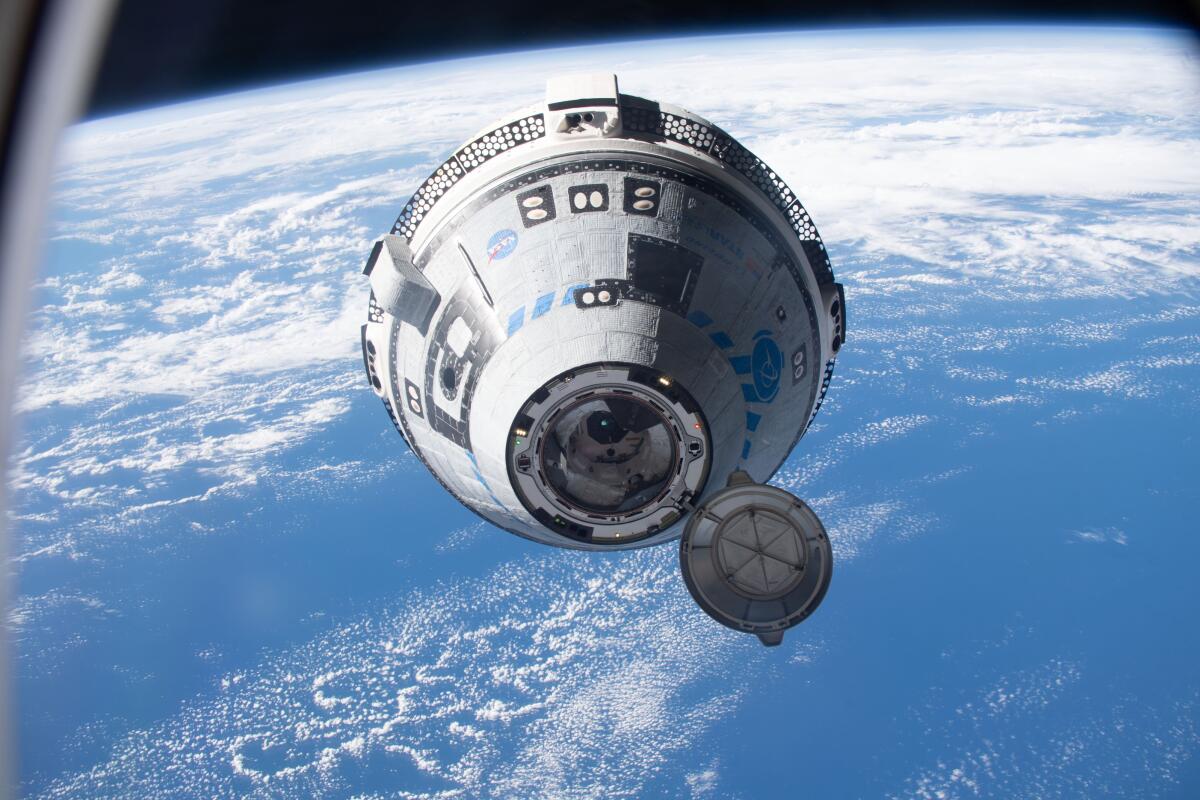After repeated delays, Starliner finally blasts into space

- Share via
Boeing’s Starliner capsule with two astronauts aboard was finally launched into space Wednesday after a series of delays that have vexed the troubled aerospace giant.
The test flight of the crew ship, developed to service the International Space Station, took off as scheduled at 7:52 a.m. Pacific time from the Cape Canaveral Space Force Station in Florida.
The capsule reached orbit after 32 minutes of flight and is expected to dock with the station around 9:15 a.m. Thursday. It’s the first time the capsule has carried astronauts after two prior uncrewed test flights.
The last scheduled launch of the CST-100 Starliner, which is years behind SpaceX in servicing the space station, was halted Saturday less than four minutes before liftoff by the ground computer that controls the final steps of the process. The problem was traced to a faulty computer power supply unit that was replaced.
The capsule was originally set to blast off May 6, but that flight was scuttled hours before liftoff because of a malfunctioning valve on the Atlas V rocket that launches it into space. The Atlas V, considered a reliable workhorse, is manufactured by United Launch Alliance, a joint venture of Boeing and Lockheed Martin.
Additional launch dates were missed last month after a helium leak was found in the Starliner’s propulsion system, which maneuvers the capsule. NASA and Boeing officials decided the leak was not serious enough to replace a defective seal, which would have taken months, and instead developed software fixes to work around it.
“For all practical purposes, SpaceX has become the player in the launch market. It’s never good to have a monopoly,” said aerospace analyst Marco Caceres of Teal Group, who applauded the flight’s initial success. “The best Boeing can hope for now is that they remain a player in this segment of the market.”
The 15-foot diameter capsule is only the sixth spacecraft that NASA astronauts have ridden in since the dawn of the Space Age, the first being the Project Mercury capsule and the most recent being SpaceX’s Crew Dragon.
Veteran astronauts Butch Wilmore and Suni Williams, who have previously flown to the space station, are expected to spend about a week testing the capsule before returning to Earth mid-month.
The capsule will touch down in the Arizona or New Mexico desert in a parachute ground landing pioneered by the Soviets decades ago, rather than the ocean landings typical of U.S. space flights. Ground landings make it easier to refit the reusable capsule for future missions, though Starliner also can land in water in an emergency.
The flight, also carrying 760 pounds of cargo to the space station, is crucial for the Arlington, Va., aerospace company, which is far behind SpaceX in launching a crewed capsule to service the space station.
Both companies were given multibillion-dollar contracts in 2014 to develop their crafts, and since 2020 Elon Musk’s Hawthorne company has ferried more than half a dozen crews aboard its Crew Dragon capsule to the station — while Boeing has managed only two remote flights, including one in May 2022 that docked with the orbiting lab.
The companies were chosen by NASA after the agency has had to rely on the Russian program to send U.S. astronauts to the station when the space shuttle program ended in 2011. Assuming the Starliner mission goes well, it would then be certified to send four-person operational crews to the station for six-month missions. NASA would then have two U.S. spacecraft to service the station, but it also plans to continue to send some American astronauts via the Russian Soyuz craft.
Russia and the U.S. were the primary builders of the space station, and play crucial roles in keeping it aloft.
Boeing has reportedly had to eat $1.5 billion in Starliner cost overruns and can ill afford a failure, especially after two crashes of its 737 Max 8 jets and the blowout of a door plug during a 737 Max 9 flight this year to Ontario International Airport in San Bernardino County.
More to Read
Inside the business of entertainment
The Wide Shot brings you news, analysis and insights on everything from streaming wars to production — and what it all means for the future.
You may occasionally receive promotional content from the Los Angeles Times.











